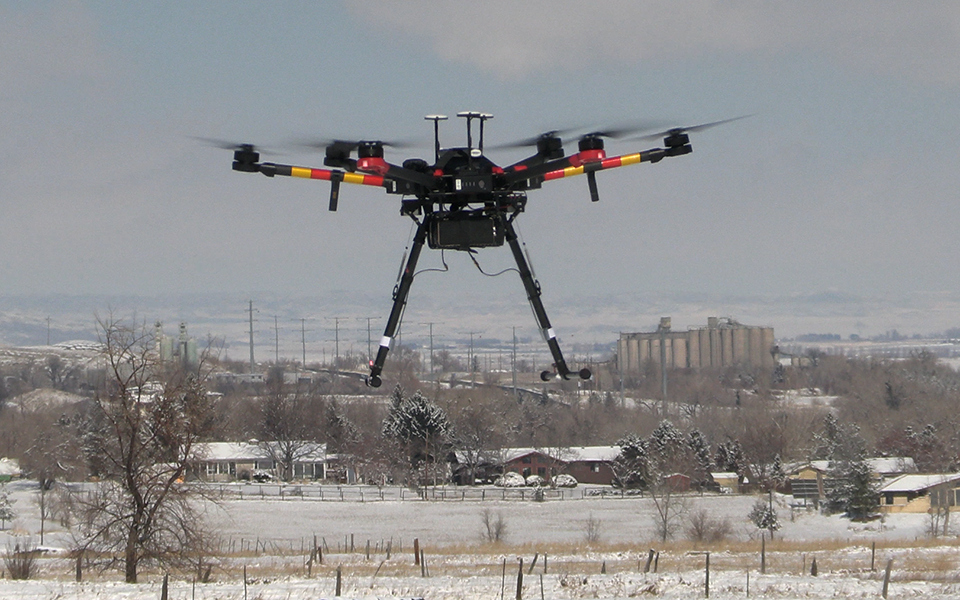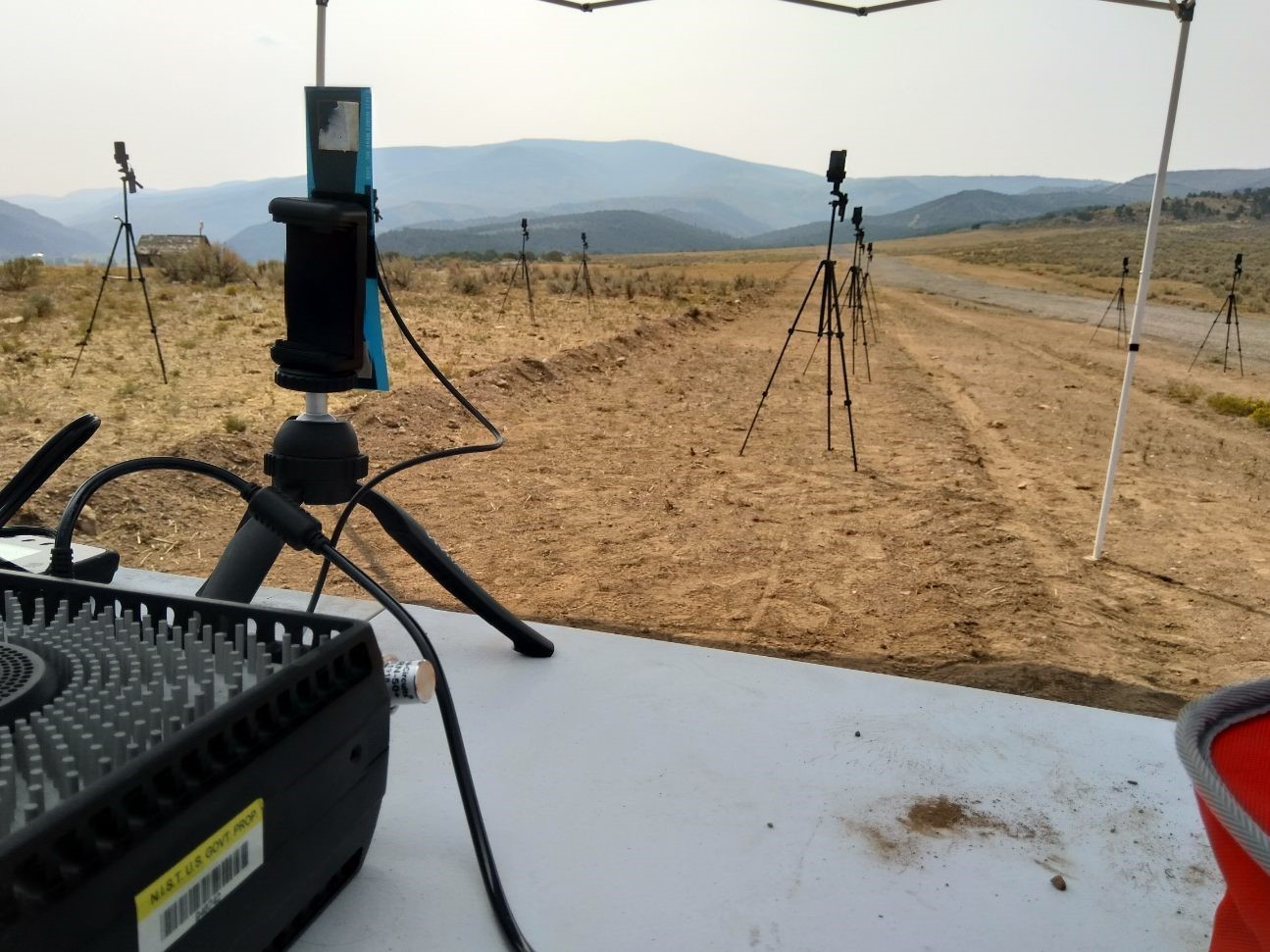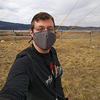Taking Measure
Just a Standard Blog

Multirotor drone with mobile LTE network.
Working outside is always a highlight for me at the National Institute of Standards and Technology (NIST). It happens more often than you might think, and probably earlier in the day, too. Last month I drove out to Fort Collins, Colorado, at 5 in the morning to conduct some measurements for my research on broadband for public safety communications and applications. My colleague, Roger Blalock, and I set up several tripods with smartphones that morning around Christman Airfield, a test airport owned by Colorado State University. It was cold and tedious, but at the same time we were both more than happy to be there. The smartphones measured connectivity data from an LTE cellular transmitter attached to a drone flying overhead. It’s a really cool idea for bringing broadband service to first responders in the field, and I hope the concept takes off (no pun intended).
The premise of my research is that because the public safety community has started to adopt new broadband-reliant technologies such as smartphone applications, there is now a need to make sure these technologies work outside of conventional coverage areas. Whether they are in a remote mountain valley fighting a wildfire or doing search and rescue just after a hurricane, first responders need to be able to use their new smartphone-based tools.
These mobile LTE networks are basically small boxes with a couple of antennas sticking out that, once turned on, put four bars on your smartphone, giving you the ability to communicate with anyone else who is connected. The goal is not to reach back to the internet, but to get local communications going. This includes communications with application services such as mapping tools or video streaming that help first responders carry out their mission.
Our research directly aims at making this concept more viable and understood so that public safety agencies could start their own aerial communications programs. We can describe best practices and expectations so that the public safety community does not have to start from scratch. At the same time, we can provide industry and academic groups with the requirements of, and feedback from, the public safety community so they can make better and better products for first responders to use.

The picture above shows one of these mobile LTE systems mounted to the underside of a multirotor drone. It’s hard to see, but the antennas are fixed to the landing gear of the drone so that once the landing gear is retracted, they point directly towards the ground. This photo was from my second trip to Christman Airfield. which makes this about the sixth time I have measured this system outside. Prior to this experiment, I had to drive four hours each way to Gypsum, Colorado, to take measurements. Our group had authorization to broadcast in Gypsum not too long ago, because commercial network coverage is sparse, so there would be a low amount of interference. Thankfully, we reached an agreement with FirstNet and AT&T to do a couple one-off experiments closer to our lab, in Fort Collins, though I do miss the fun of long drives on I-70 in the morning. I remember on one occasion I went down to Gypsum for some flight testing at a private airfield next to town. The plan was to fly a fixed-wing drone there to observe connectivity from an orbiting LTE base station. Unfortunately, the drone never took off, as the gravel runway broke the propellers. Although the flight was a bust, we were still able to collect some good ground measurements that weekend.
Prior to the disastrous flight day, I had obtained permission from the landowners to set up a tent next to the airfield so that I could camp out the night before and wake up bright and early for testing. I never would have thought that studying electrical engineering would give me the chance to camp in the mountains for my research.
I have been with NIST for over four years now, working on the Highly Mobile Deployed Networks project, a project sponsored by the Department of Homeland Security (DHS) Science and Technology Directorate. I started out at NIST as an undergraduate intern from the University of Colorado Boulder before becoming a full-time employee. I am currently studying electrical engineering as a master’s student at CU with a focus in radio frequency propagation and communication systems. My time here at NIST has been spent investigating this same topic, mobile broadband for public safety, and I am still very happy to continue with it.
Our group at NIST has always been focused on helping the public safety community, and this research area is very pertinent to today’s public safety needs. I have talked at length with people in public safety about how, at the end of the day, they just want something that works, and connected smartphones are always on the top of the list. How do we get them wireless coverage? That is our goal, and that is why we are taking these measurements. We want to answer that question and provide as much technical advice as we can.
The project has not been without some setbacks, from drones crashing, to equipment overheating, to dead phones. Lots of trial and error has been put into this work, along with lots of time spent coming up with the best way to carry out our research. I remember a dark day in Gypsum when the drone crashed right at takeoff after a connector on one of the spectrum analyzers snapped off. On top of that, the other spectrum analyzer started to malfunction, leaving us with no other option but to pack up and go home with nothing. I don’t look forward to more days like that, but sometimes we need them to help inform and improve our processes.

Every setback led to an improvement or a new idea—a new solution that made the following experiment better. For example, we started using smartphones scattered throughout the area to measure the systems coverage area instead of spectrum analyzers, which are difficult to use in the field (we learned that the hard way lugging these systems around in the heat). It turned out that we also get better, more direct data on what the system can provide in terms of coverage to a smartphone by using smartphones to do the measurements.

Although it has not always been easy to collect the data we needed for this work, we have made really good progress. Most of our work is delivered to DHS internally, but we have shared our work every year during the NIST Public Safety Communications Research Division’s (PSCR) annual stakeholder meeting. We have talked with several public safety, industry and academic groups about our work, helping them guide their goals. Today, I am still parsing through some of our aerial measurement data to get it ready for a NIST publication that I hope to release soon. I am reminded after writing this post it’s hardly ever easy to accomplish something worthwhile, but that it’s always worth it.






Very interesting work. I've been experimenting with payload radios for the past few months, focusing on reception and triangulation of RFI. I've also done some very preliminary work with amateur radio VHF/UHF transceivers with some interesting results.